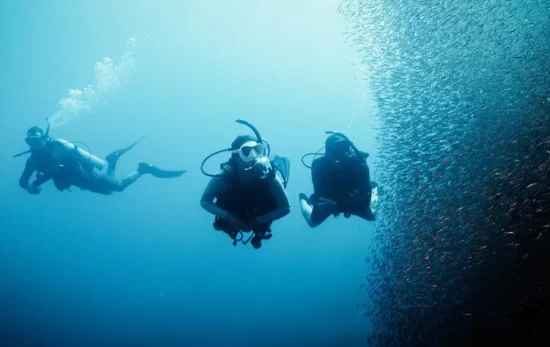The PADI Open Water Diver certification course is just the tip of the iceberg when it comes to scuba diving knowledge. Once you’re a certified scuba diver, you’ll likely want to continue your education and learn special skills to enhance your diving experiences. PADI Specialty Diver courses are a great way to expand your scuba knowledge. These courses are more granular than the ‘core’ courses, usually focusing on a specific dive skill, such as buoyancy, photography, or fish identification.
Taking a specialty course is easier than ever now that many of the courses are available with eLearning. This option provides a convenient way to complete the independent study portion of the course. You can study at your own pace on your desktop, laptop or mobile device. This also cuts down on the paper products needed to produce educational course materials.
Wondering which specialty course to take first? Here are the five most popular PADI Specialty courses right now.

1. Enriched Air (Nitrox) Diver
The Enriched Air Diver course (also called Nitrox) is the most popular PADI Specialty course. This is no surprise, because diving with Nitrox instead of air means you can extend your bottom times and enjoy shorter surface intervals! The air we breathe on Earth’s surface is approximately 79% nitrogen and 21% oxygen, while the Nitrox mix that divers use features more oxygen and less nitrogen. Less nitrogen in the gas mixture means less nitrogen absorption during a dive, which is often the limiting factor when it comes to dive times and depths. Read more about the benefits of diving Nitrox versus air.

2. Deep Diver
Want to explore more of the amazing ocean world? With depth, the aquatic world changes vastly in terms of pressure, temperature, light, and where animals and algae live. After taking the Deep Diver course, you will be able to dive to a maximum depth of 40m/130ft. During the course, you’ll learn how to manage your gas supply and how to identify and address narcosis. Proper training before diving deeper is important, so be sure to take this course before you venture deeper than your current certification level.

3. Dry Suit Diver
The Dry Suit Diver course is a great specialty course to take if you want to dive in colder waters. Cold waters are nutrient-rich and teeming with life! And, there are great dive sites in cold waters you won’t want to miss, but you should learn how to dive in a dry suit to ensure your comfort on your adventure. Dry suits keep you dry and warm by using air to insulate you and preventing water from coming into contact with your undergarments and skin. This course will teach you how to manage the air in your drysuit along with your buoyancy, how to choose a drysuit and undergarments, and how care for your drysuit. Read more about why you need a dry suit certification.

4. Peak Performance Buoyancy
Is one of your goals to dive effortlessly and efficiently? Then the Peak Performance Buoyancy course is the PADI Specialty course for you! This course will train you how to achieve neutral buoyancy and hover effortlessly in vertical or horizontal positions, allowing you to consume your air supply more efficiently. Not only will excellent buoyancy improve your diving performance and experiences, but it will also benefit the dive sites and marine fauna, because you will be less likely to damage the seafloor or reef.

5. Wreck Diver
Wrecks are fascinating dive sites, ranging from artificial reefs and sunken ships to crashed planes and more. The fifth most popular PADI Specialty course is the Wreck Diver course, a truly adventurous course because you will gain the skills to responsibly observe wrecks. You’ll learn how to explore inside wrecks, how to use lines and reels, and how to use special finning techniques. Interested in learning more? Read these five tips for wreck diving.

PADI Specialty Courses
Don’t wait to improve your diving skills and thrive in the water! Remember that eLearning is available for all of the most popular PADI Specialty courses, making it easy to learn these valuable diving skills at your own pace and schedule.
Get Your Master Scuba Diver Rating – for Free!
Ready to push your limits and explore more of the underwater world? Now is the perfect time to earn recreational diving’s highest and most prestigious rating. For a limited time, PADI is waiving all Master Scuba Diver application fees.
Complete the requirements — five PADI Specialty Diver certifications, Rescue Diver and 50 logged dives — then submit your application before the end of the year. Don’t miss the chance to join this elite group of divers.




